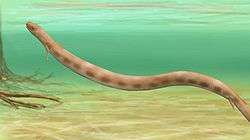Lysorophia
| Lysorophians Temporal range: Pennsylvanian–Cisuralian | |
|---|---|
 | |
| Life restoration of Brachydectes newberryi | |
| Scientific classification | |
| Kingdom: | Animalia |
| Phylum: | Chordata |
| Clade: | Reptiliomorpha |
| Subclass: | †Lepospondyli |
| Order: | †Lysorophia Romer, 1930 |
| Family: | †Cocytinidae Cope, 1875 |
| Genera | |
| Synonyms | |
Lysorophia is an order of aquatic Carboniferous and Permian amphibians within the extinct subclass Lepospondyli. Lysorophians resembled small snakes, as their bodies are extremely elongate. There is a single family, the Cocytinidae (previously known as Lysorophidae). Currently there are around five genera included within Lysorophia.
Description
The skull is lightly built and open, with large orbits and fenestrae. The intertemporal, supratemporal, postfrontal, and jugal bones of the skull have disappeared. The mandibles are short, and the maxilla and premaxilla freely movable.

The torso is very elongate, the limbs diminutive or absent, and the tail short. There are up to 99 pre-sacral (i.e. not including the hips and tail) vertebrae.
Based on morphology of the cranio-vertebral articulation, Lysorophids are usually considered to be related to the Microsauria, although the pattern of bones of the skull is very different.[1]
Distribution
Lysorophians are known mainly from the Pennsylvanian and Early Permian of North America.[2] In North America, fossils of lysorophians have been found from places such as the Chinle Formation in San Juan County, Utah and the Mazon Creek fossil beds in Grundy County, Illinois. Carboniferous lysorophians are also known from Europe, having been found from England and Ireland. Possible remains of a lysorophian have also been found from La Machine, France, although they may belong to an aïstopod.[1][3]
References
- 1 2 Wellstead, C. F. (1991). "Taxonomic revision of the Lysorophia, Permo-Carboniferous lepospondyl amphibians" (PDF). Bulletin of the American Museum of Natural History. 209: 1–90.
- ↑ Cannatella, D.C.; Vieites D.R.; ZHang P.; Wake M.H.; Wake D.B. (2009). "Amphibians (Lissamphibia)". In Hedges S.B. & Kumar S. The Timetree of Life. Oxford University Press. p. 354. ISBN 9780191608988. Retrieved 3 December 2012.
- ↑ Baird, D. (1964). "The aïstopod amphibians surveyed". Brevioria. 206: 1–17.
General references
- Carroll, RL (1988), Vertebrate Paleontology and Evolution, WH Freeman & Co. p. 180
- von Zittel, K.A (1932), Textbook of Paleontology, C.R. Eastman (transl. and ed), 2nd edition, vol.2, p. 225-6, Macmillan & Co.
.png)